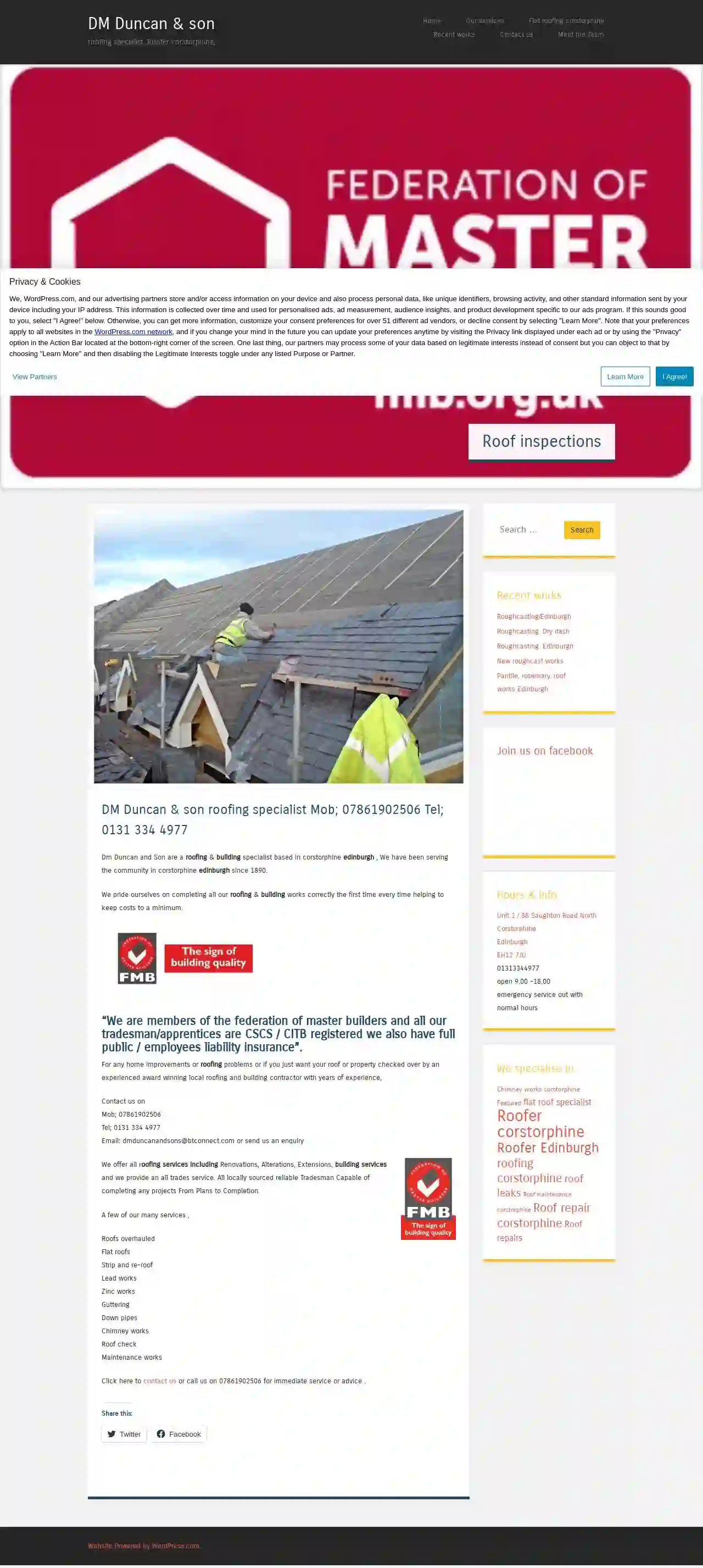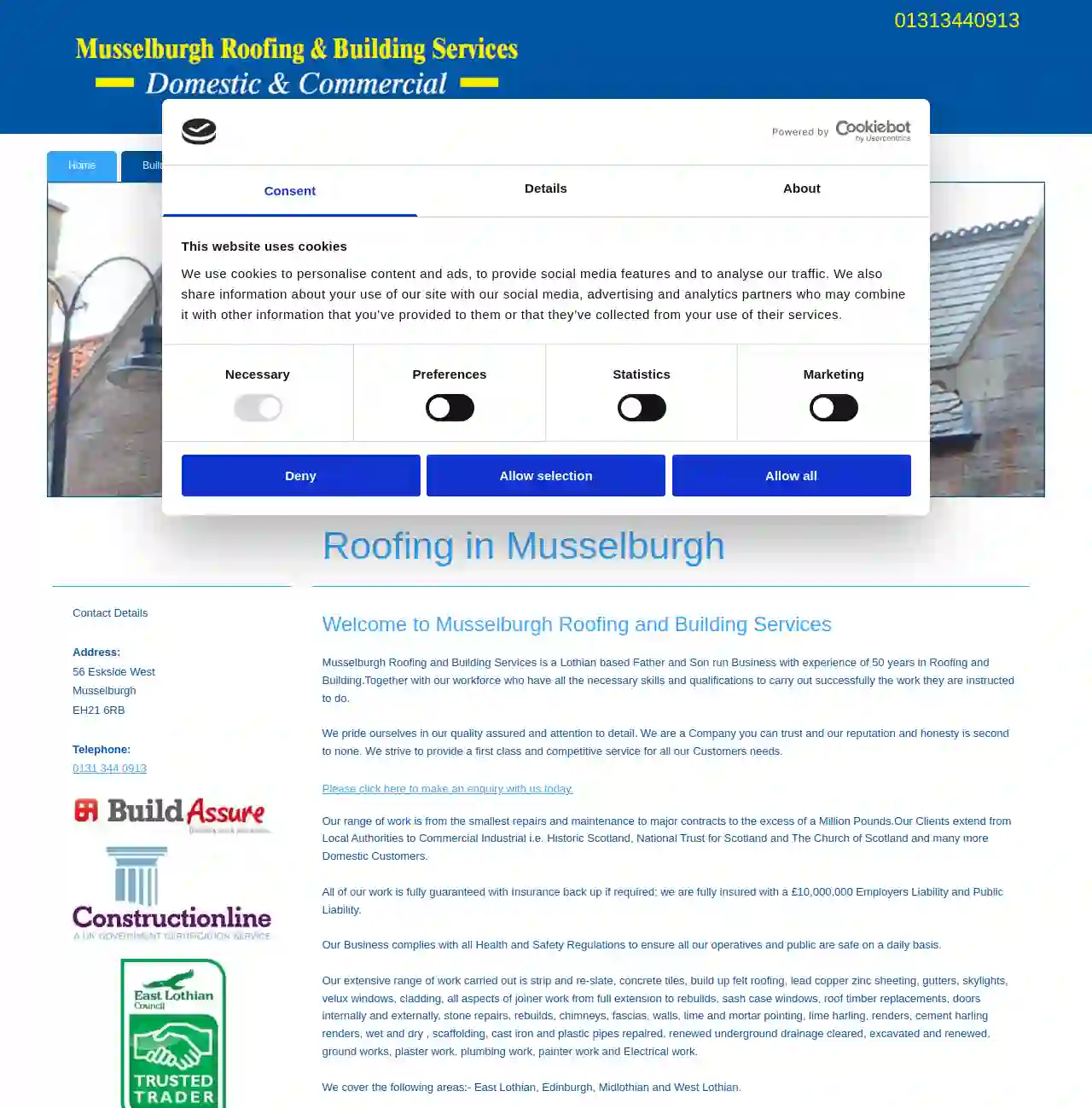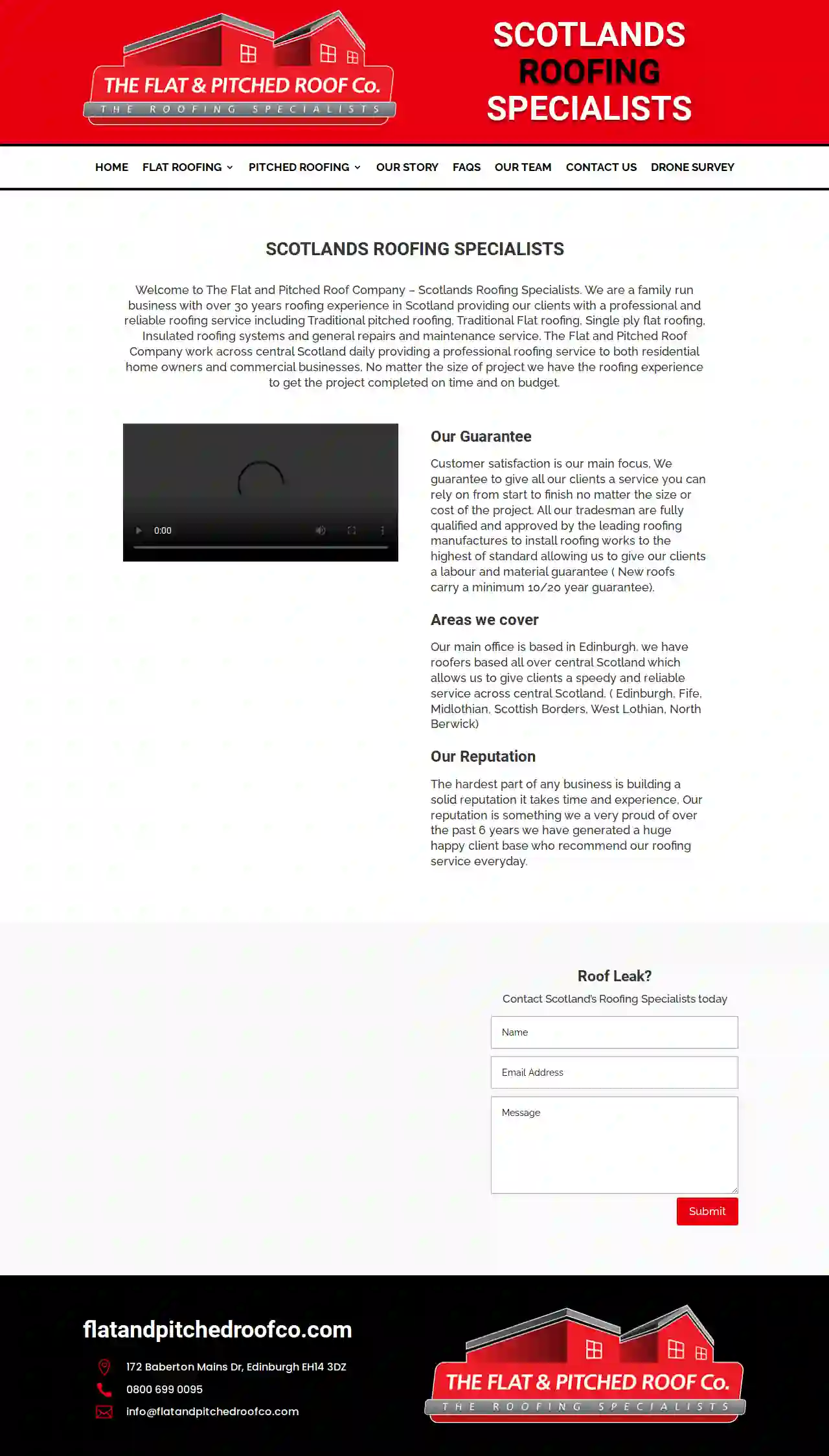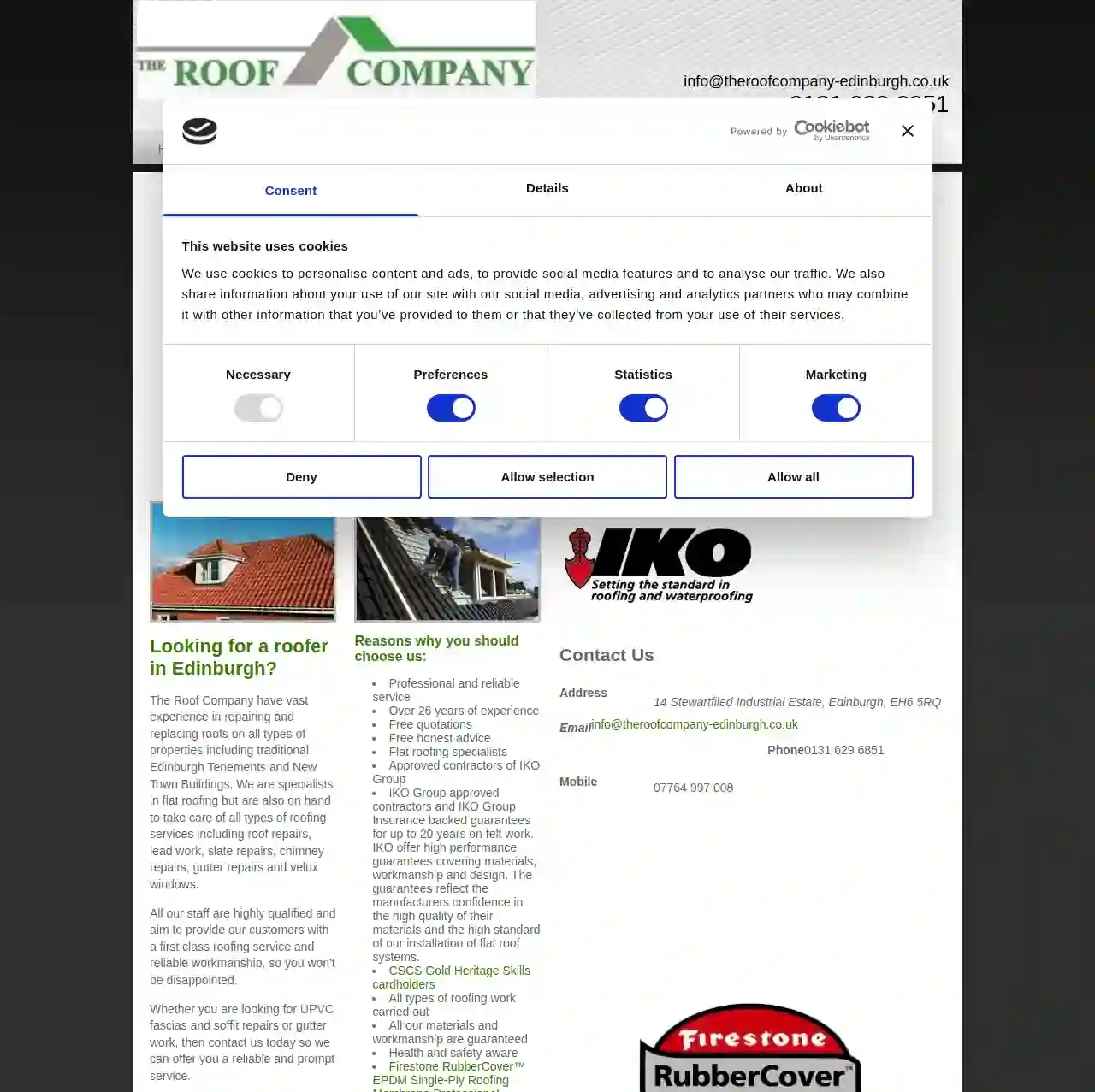Rubber Roof Installers Edinburgh
Find top Rubber Roof Installers in Edinburgh
Receive up to 3 Rubber Roof Installer quotes for your project today! Compare profiles, reviews, accreditations, portfolio, etc... and choose the best offer.

Edinburgh Borders Roofing
4.544 reviewsEdinburgh, GBEdinburgh Borders Roofing is a 5-star rated Edinburgh roofing company offering a wide range of services including new roofs, roof repairs, chimney rebuilds and repairs, roof slating and tiling, leadwork, stonemasonry, exterior render, and solar panel installation. Our team of expert roofers has over 20 years of experience and is fully insured and guaranteed. We provide a comprehensive free photographic survey, a full written quotation, and a no-obligation quote. Our services are available in Edinburgh, surrounding areas, and the Scottish Borders. We're dedicated to providing exceptional customer service, competitive pricing, and high-quality workmanship.
- Services
- Why Us?
- Gallery
Get Quote
Stuart & Moffat Roofing Contractors - Edinburgh
53 reviewsUnit 44, Mayfield Industrial Estate, Dalkeith., Dalkeith, EH22 4AD, GBStuart & Moffat Roofing is a trusted roofing company in Edinburgh, providing a full range of roofing services including roof replacement, roof repair, flat roofs, chimney work, Velux windows, gutters and downpipes. Established in 2019, our Directors Danny and Malcolm have over 20 years’ experience in delivering roofing excellence and share a passion for customer care. We serve East Lothian, Midlothian & Edinburgh. No job is considered too big or too small. When you get in touch, we will arrange a free photographic survey of your roof and then provide you with a detailed quotation. All our work is carried out to the highest standard of workmanship with meticulous attention to detail. We are fully insured, all of our new roofs come with a full guarantee and we provide a comprehensive after care service to give you complete peace of mind. As experienced roofers, we know that when you have roof problems they need to be dealt with quickly to minimise any internal damage to your property. That is why we believe clear transparent communication is essential so that you know exactly what is happening and when. We also understand how much of an inconvenience roof repairs or roof replacement can be for clients. For this reason, we will work efficiently and tirelessly to ensure that disruption is kept to an absolute minimum during the entirety of the project.
- Services
- Why Us?
- Accreditations
- Our Team
- Testimonials
- Gallery
Get Quote
Edinburgh Property Maintenance Ltd
44 reviews3 Cluny Avenue, Edinburgh, EH10 4RN, GBEdinburgh Property Maintenance Ltd is a family-run business established in 1979, providing high-quality property maintenance services for both domestic and commercial clients across Edinburgh and the surrounding areas. We are known for our skilled tradesmen and commitment to excellent customer service. Our services include roofing, building, and general repairs, ensuring your property is well-maintained and in top condition. We pride ourselves on our free expert consultations and no-obligation quotes, allowing you to make informed decisions about your property maintenance needs. With over 30 years of experience, Edinburgh Property Maintenance Ltd is your trusted partner for all your property maintenance requirements.
- Services
- Why Us?
- Testimonials
- Gallery
Get Quote
Dm Duncan & Son
57 reviewsGBDM Duncan & son are a roofing & building specialist based in corstorphine edinburgh, We have been serving the community in corstorphine edinburgh since 1890.We pride ourselves on completing all our roofing & building works correctly the first time every time helping to keep costs to a minimum. “We are members of the federation of master builders and all our tradesman/apprentices are CSCS / CITB registered we also have full public / employees liability insurance”.For any home improvements or roofing problems or if you just want your roof or property checked over by an experienced award winning local roofing and building contractor with years of experience,Contact us onMob; 07861902506Tel; 0131 334 4977Email: [email protected] or send us an enquiryWe offer all roofing services including Renovations, Alterations, Extensions, building services and we provide an all trades service. All locally sourced reliable Tradesman Capable of completing any projects From Plans to Completion.A few of our many services ,Roofs overhauledFlat roofsStrip and re-roofLead worksZinc worksGutteringDown pipesChimney worksRoof checkMaintenance worksClick here to contact us or call us on 07861902506 for immediate service or advice .
- Services
- Why Us?
- Accreditations
- Our Team
- Testimonials
- Gallery
Get Quote
Musselburgh Roofing & Building Services
52 reviews56 Eskside West, Musselburgh, EH21 6RB, GBMusselburgh Roofing and Building Services is a Lothian based Father and Son run Business with experience of 50 years in Roofing and Building. Together with our workforce who have all the necessary skills and qualifications to carry out successfully the work they are instructed to do. We pride ourselves in our quality assured and attention to detail. We are a Company you can trust and our reputation and honesty is second to none. We strive to provide a first class and competitive service for all our Customers needs. Please click here to make an enquiry with us today. Our range of work is from the smallest repairs and maintenance to major contracts to the excess of a Million Pounds.Our Clients extend from Local Authorities to Commercial Industrial i.e. Historic Scotland, National Trust for Scotland and The Church of Scotland and many more Domestic Customers.All of our work is fully guaranteed with Insurance back up if required; we are fully insured with a £10,000,000 Employers Liability and Public Liability.Our Business complies with all Health and Safety Regulations to ensure all our operatives and public are safe on a daily basis.Our extensive range of work carried out is strip and re-slate, concrete tiles, build up felt roofing, lead copper zinc sheeting, gutters, skylights, velux windows, cladding, all aspects of joiner work from full extension to rebuilds, sash case windows, roof timber replacements, doors internally and externally, stone repairs, rebuilds, chimneys, fascias, walls, lime and mortar pointing, lime harling, renders, cement harling renders, wet and dry , scaffolding, cast iron and plastic pipes repaired, renewed underground drainage cleared, excavated and renewed, ground works, plaster work, plumbing work, painter work and Electrical work.We cover the following areas:- East Lothian, Edinburgh, Midlothian and West Lothian.
- Services
- Why Us?
- Accreditations
- Gallery
Get Quote
Rhino Roofing Edinburgh
59 reviewsEdinburgh, The Lothians & Fife, EH1 1AA, GBRhino Roofing Edinburgh is a family-run roofing business serving Edinburgh, The Lothians & Fife for many years. They pride themselves on being professional, reliable, and customer-focused. With over 10 years of experience, they guarantee high-quality workmanship, using the best materials and working within client budgets. Rhino Roofing Edinburgh is known for completing projects on time and to the highest standards, offering free no-obligation quotes and up to 20-year guarantees on new roofs.
- Services
- Why Us?
- Our Team
- Testimonials
- Gallery
Get Quote
Edinburgh's First Response Roofing
512 reviews56-60 Duddingston Park South, Edinburgh, GBEdinburgh's First Response Roofing - Expert Local Roofers. Protecting your Edinburgh home starts with a reliable roof, and Edinburgh's First Response Roofing has been the trusted choice for nearly 20 years. Our unwavering expertise and unmatched commitment to roof replacement and installation make us the number one choice in Edinburgh. Rest easy knowing that our market-leading 10-year insurance backed guarantee ensures unbeatable quality for your peace of mind.
- Services
- Why Us?
- Our Team
- Gallery
Get Quote
Edinburgh Roofing Services
4.8435 reviews58 Mayfield Road, Edinburgh, EH9 2NH, GBEdinburgh Roofing Services are one of Edinburgh’s best rated roof contractors. We have been in the roofing & building industry for over 20 years providing customers with a full range of roofing services. From flat roofs, traditional roofing and single ply rubber roofing to complete refurbishments and fresh roof installations.When you are looking for a roofing contractor who can be trusted to carry out any work to the highest standards from start to completion, Edinburgh Roofing Services are the roofers widely regarded in Edinburgh to be the roofers of choice.We’ve achieved our prestigious reputation and are widely regarded as being one of Edinburgh’s premier roofing companies by staying true to our main objectives. Customer satisfaction is our top priority. We always complete the job on time, to the highest standard possible. Our roofers only use the best materials, and as a responsible company, we complete projects to within the client’s estimated budget.Edinburgh Roofing Services work daily throughout the city dealing with customers ranging from private homeowners, to big businesses and large housing associations. Roofers employed by us are all very highly trained at the work they carry out and have many years of experience in using their expert skills on any project regardless of size or complexity.
- Services
- Why Us?
- Accreditations
- Our Team
- Gallery
Get Quote
The Pitched Roof Co.
172 Baberton Mains Dr, Edinburgh, EH14 3DZ, GBSCOTLANDS ROOFING SPECIALISTS Welcome to The Flat and Pitched Roof Company – Scotlands Roofing Specialists. We are a family run business with over 30 years roofing experience in Scotland providing our clients with a professional and reliable roofing service including Traditional pitched roofing, Traditional Flat roofing, Single ply flat roofing, Insulated roofing systems and general repairs and maintenance service. The Flat and Pitched Roof Company work across central Scotland daily providing a professional roofing service to both residential home owners and commercial businesses. No matter the size of project we have the roofing experience to get the project completed on time and on budget. Customer satisfaction is our main focus, We guarantee to give all our clients a service you can rely on from start to finish no matter the size or cost of the project. All our tradesman are fully qualified and approved by the leading roofing manufactures to install roofing works to the highest of standard allowing us to give our clients a labour and material guarantee ( New roofs carry a minimum 10/20 year guarantee). Our main office is based in Edinburgh, we have roofers based all over central Scotland which allows us to give clients a speedy and reliable service across central Scotland. ( Edinburgh, Fife, Midlothian, Scottish Borders, West Lothian, North Berwick) The hardest part of any business is building a solid reputation it takes time and experience, Our reputation is something we a very proud of over the past 6 years we have generated a huge happy client base who recommend our roofing service everyday. Roof Leak? Contact Scotland’s Roofing Specialists today flatandpitchedroofco.com 172 Baberton Mains Dr, Edinburgh EH14 3DZ 0800 699 0095 [email protected]
- Services
- Why Us?
- Gallery
Get Quote
The Roof Company
2.73 reviews14 Stewartfiled Industrial Estate, Edinburgh, EH6 5RQ, GBLooking for a roofer in Edinburgh? The Roof Company have vast experience in repairing and replacing roofs on all types of properties including traditional Edinburgh Tenements and New Town Buildings. We are specialists in flat roofing but are also on hand to take care of all types of roofing services including roof repairs, lead work, slate repairs, chimney repairs, gutter repairs and velux windows. All our staff are highly qualified and aim to provide our customers with a first class roofing service and reliable workmanship, so you won't be disappointed. Whether you are looking for UPVC fascias and soffit repairs or gutter work, then contact us today so we can offer you a reliable and prompt service. Reasons why you should choose us: Professional and reliable service Over 26 years of experience Free quotations Free honest advice Flat roofing specialists Approved contractors of IKO Group IKO Group approved contractors and IKO Group Insurance backed guarantees for up to 20 years on felt work. IKO offer high performance guarantees covering materials, workmanship and design. The guarantees reflect the manufacturers confidence in the high quality of their materials and the high standard of our installation of flat roof systems. CSCS Gold Heritage Skills cardholders All types of roofing work carried out All our materials and workmanship are guaranteed Health and safety aware Firestone RubberCover™ EPDM Single-Ply Roofing Membrane Professional Installers
- Services
- Why Us?
- Accreditations
- Gallery
Get Quote
Over 12,314+ Roofers on our platform
Our roofing contractors operate in Edinburgh & beyond!
Roofyng.co.uk has curated and vetted the Best Roofers arround Edinburgh. Find a top & trustworthy contractor today.
Rubber Roof Installation FAQs
- Membrane thickness
- Installation quality
- Climate and weather exposure
- Regular maintenance
- Age: If your flat roof is nearing the end of its expected lifespan (15-30 years for most flat roofing systems), a replacement is usually a better investment than continual repairs.
- Extensive Damage: If the roof has experienced significant damage, such as widespread leaks, ponding water, or structural issues, replacement is often more cost-effective than trying to repair multiple problems.
- Recurring Leaks: If you've had multiple leaks that have been repaired but keep reappearing, it could indicate a systemic problem with the roofing system that warrants a replacement.
- Deteriorated Membrane: If the waterproofing membrane is showing signs of widespread deterioration, cracking, blistering, or alligatoring (a pattern of cracks resembling alligator skin), it's likely time for a replacement.
- Energy Efficiency: If your flat roof is poorly insulated, resulting in high energy bills, a replacement with a more energy-efficient roofing system could be a wise investment.
- The size and complexity of the roof
- The thickness of the EPDM membrane (45 mil, 60 mil, 90 mil)
- The installation method (fully adhered, mechanically attached, ballasted)
- Whether the existing roof needs to be removed
- The cost of insulation and other materials
- Labor costs in your region
- Condition of the Existing Roof: The existing rubber roof should be in relatively good condition, with no significant damage or ponding water issues.
- Number of Layers: Most building codes allow only one layer of roof overlay. If your existing roof already has an overlay, a complete tear-off is usually required.
- Compatibility: Ensure the new EPDM membrane is compatible with the old one and that the adhesive will bond effectively to the existing surface.
- Local Building Codes: Check with your local building department to verify if roof overlays are permitted and if any specific requirements apply.
How long do rubber roofs last?
How do I know if my flat roof needs replacing?
How much does a rubber roof cost in the UK?
Can you put a new rubber roof over an old one?
How long do rubber roofs last?
- Membrane thickness
- Installation quality
- Climate and weather exposure
- Regular maintenance
How do I know if my flat roof needs replacing?
- Age: If your flat roof is nearing the end of its expected lifespan (15-30 years for most flat roofing systems), a replacement is usually a better investment than continual repairs.
- Extensive Damage: If the roof has experienced significant damage, such as widespread leaks, ponding water, or structural issues, replacement is often more cost-effective than trying to repair multiple problems.
- Recurring Leaks: If you've had multiple leaks that have been repaired but keep reappearing, it could indicate a systemic problem with the roofing system that warrants a replacement.
- Deteriorated Membrane: If the waterproofing membrane is showing signs of widespread deterioration, cracking, blistering, or alligatoring (a pattern of cracks resembling alligator skin), it's likely time for a replacement.
- Energy Efficiency: If your flat roof is poorly insulated, resulting in high energy bills, a replacement with a more energy-efficient roofing system could be a wise investment.
How much does a rubber roof cost in the UK?
- The size and complexity of the roof
- The thickness of the EPDM membrane (45 mil, 60 mil, 90 mil)
- The installation method (fully adhered, mechanically attached, ballasted)
- Whether the existing roof needs to be removed
- The cost of insulation and other materials
- Labor costs in your region
Can you put a new rubber roof over an old one?
- Condition of the Existing Roof: The existing rubber roof should be in relatively good condition, with no significant damage or ponding water issues.
- Number of Layers: Most building codes allow only one layer of roof overlay. If your existing roof already has an overlay, a complete tear-off is usually required.
- Compatibility: Ensure the new EPDM membrane is compatible with the old one and that the adhesive will bond effectively to the existing surface.
- Local Building Codes: Check with your local building department to verify if roof overlays are permitted and if any specific requirements apply.